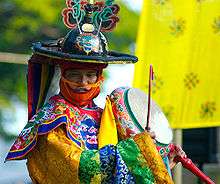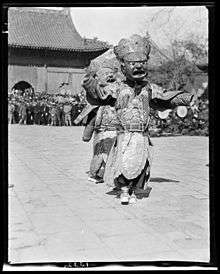Cham dance
The cham dance (Tibetan: འཆམ་, Wylie: 'cham )[2][3] is a lively masked and costumed dance associated with some sects of Tibetan Buddhism and Buddhist festivals. The dance is accompanied by music played by monks using traditional Tibetan musical instruments. The dances often offer moral instruction relating to karuṇā (compassion) for sentient beings and are held to bring merit to all who perceive them.[1][4]

Chams are considered a form of meditation and an offering to the gods.[5] The leader of the cham is typically a musician, keeping time using some percussion instrument like cymbals, the one exception being Dramyin Cham, where time is kept using dramyin.
The term "devil dance" was an early 20th century Western description of the performance; its name was derived from the costumes worn by performers.[5]
Origins

The origins of chams can be traced back to the ritual dances of the Newar people of the Kathmandu valley. The ritual dance traditions of Pyakha were one of the many influences Kathmandu had brought over to Tibetan art, architecture, and religion.
Content
Chams often depict incidents from the life of Padmasambhava, the 9th century Nyingmapa teacher, and other saints.[6]
The great debate of the Council of Lhasa between the two principal debators or dialecticians, Moheyan and Kamalaśīla is narrated and depicted in a specific cham dance once held annually at Kumbum Monastery in Qinghai.[7] One iteration of this dance is performed on the eve of Losar, the Tibetan new year, to commemorate the assassination of the cruel Tibetan king, Langdarma in 841 CE. It is a dance symbolising the victory of good over evil.[8]
The Black Hat dance is a Vajrakilaya dance and is the dance most frequently depicted in paintings.[9]
Localities
Bhutan
.jpg)
In Bhutan, the dances are performed during an annual religious festival known as Tshechu, which is held in each district. The Cham is performed by monks, nuns, and villagers. The Royal Academy of Performing Arts is the main body which promotes the preservation of the culture of Cham and the dances.
India
Dances are performed in Lahaul and Spiti district, Sikkim, Dharamshala and Ladakh during cultural and religious festivals.
Tibet
Tibetans usually perform chams to large audiences during the Monlam Prayer Festival.[10]
See also
References
- Pearlman, Ellen (2002). Tibetan Sacred Dance: a Journey into the Religious and Folk Traditions. Inner Traditions / Bear & Co. pp. 21, 32, 180. ISBN 978-0-89281-918-8. Retrieved 16 October 2011.
- "༈ རྫོང་ཁ་ཨིང་ལིཤ་ཤན་སྦྱར་ཚིག་མཛོད། ༼འཆ-༽" [Dzongkha-English Dictionary: "'CHA"]. Dzongkha-English Online Dictionary. Dzongkha Development Commission, Government of Bhutan. Archived from the original on 29 July 2012. Retrieved 11 November 2011.
- "Tibetan-English-Dictionary of Buddhist Teaching & Practice". Diamond Way Buddhism Worldwide. Rangjung Yeshe Translations & Publications. 1996. Archived from the original on 28 March 2010. Retrieved 11 November 2011. entry: 'cham.
- Clements, William M. (2006). The Greenwood Encyclopedia of World Folklore and Folklife: Southeast Asia and India, Central and East Asia, Middle East. 2. Greenwood Press. pp. 106–110. ISBN 978-0-313-32849-7. Retrieved 16 October 2011.
- Schrempf, Mona (1995). "From 'Devil Dance' to 'World Healing': Some Representations, Perceptions, and Innovations of Contemporary Tibetan Ritual Dances". In Korom, Frank J.; Steinkeller, Ernst (eds.). Proceedings of the 7th Seminar of the International Association for Tibetan Studies: Graz 1995. vol. 4. Wien: Verlag der Österreichischen Akademie der Wissenschaften. pp. 91–102. ISBN 370012659X. OCLC 37538399.
- Dancing on the demon's back: the dramnyen dance and song of Bhutan, by Elaine Dobson, John Blacking Symposium: Music, Culture and Society, Callaway Centre, University of Western Australia, July 2003
- Roccasalvo, Joseph F.(1980). 'The debate at bsam yas: religious contrast and correspondence.' Philosophy East and West 30:4 (October 1980). The University of Press of Hawaii. Pp.505-520. Source: Archived 3 March 2016 at the Wayback Machine (accessed: 17 December 2007)
- "Lossar Festival". Archived from the original on 20 January 2008.
- Chitipati/Shri Shmashana Adhipati (protector) - at Himalayan Art Resources
- "Backgrounder: Monlam Prayer Festival". Focus on Tibet. Xinhua. 28 February 2010. Archived from the original on 25 April 2012. Retrieved 2 February 2011.
Further reading
- Forman, Werner (photographs) & Rintschen, Bjamba (text) Lamaistische Tanzmasken: der Erlik-Tsam in der Mongolei. Leipzig: Koehler & Amelang, 1967 (text translated into German from Russian)
External links
| Wikimedia Commons has media related to Cham dance. |